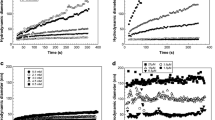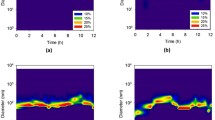Abstract
The purpose of this study was to determine and understand the aggregation behaviour of industrial nanoparticulate TiO2 (NPs) in the river water near a TiO2 production plant. The aggregation was tested in near-reality conditions with industrial NPs and the filtered river water in which they are potentially released. The initial size of TiO2 NPs is around 5 nm. The evolution of the hydrodynamic diameters of the TiO2 aggregates in the presence of added Suwannee River fulvic acid (SRFA) and illite in the filtered river water was measured at pH 8 for at least 30 min with dynamic light scattering and laser diffraction. The experiments performed in the filtered river water allowed the determination of the attachment efficiency coefficients, and the experiments performed under conditions facilitating aggregation (with higher Ca2+ content) were used to understand the potential aggregation processes. When no Ca2+ was added into the river water, the initially aggregated TiO2 did not develop a secondary aggregation in the presence of SRFA and illite. Upon the addition of 2.75 mM Ca2+, TiO2 was shown to heteroaggregate with illite at all tested concentrations. Consequently, in the studied river, the fate of the TiO2 NPs does not seem to be related to that of the clay suspended particles upstream of the plant. However, the behaviours of the TiO2 NPs and the clays are closely linked in the water with higher salt content, which is the case downstream of one of the industrial effluent release points.
Graphical Abstract







Similar content being viewed by others
References
Adam V, Loyaux-Lawniczak S, Quaranta G (2015) Characterization of engineered TiO2 nanomaterials in a life cycle and risk assessments perspective. Environ Sci Pollut Res 105:731–738
AERM (Agence de l’Eau Rhin Meuse) (2013). http://rhin-meuse.eaufrance.fr/choixtheme?lang=fr. Accessed 10 June 2015
Benlot C, Blanchouin N (2005). www.snv.jussieu.fr/bmedia/aa/aa1.html. Accessed June 2015
Bouyer D, Coufort C (2005) Experimental analysis of floc size distributions in a 1-L jar under different hydrodynamics and physicochemical conditions. J Colloid Interface Sci 292:413–428
Chowdhury I, Walker SL, Mylon SE (2013) Aggregate morphology of nano-TiO2: role of primary particle size, solution chemistry, and organic matter. Environ Sci Process Impacts 15:275. doi:10.1039/c2em30680h
Domingos RF, Tufenkji N, Wilkinson KJ (2009) Aggregation of titanium dioxide nanoparticles: role of a fulvic acid. Environ Sci Technol 43:1282–1286. doi:10.1021/es8023594
Elimelech M, Gregory J, Jia X, Williams RA (1995) Particle deposition & aggregation: measurement, modelling and simulation. Elsevier, New York. ISBN 978-0-7506-0743-8
Erhayem M, Sohn M (2014) Stability studies for titanium dioxide nanoparticles upon adsorption of Suwannee River humic and fulvic acids and natural organic matter. Sci Total Environ 468–469:249–257. doi:10.1016/j.scitotenv.2013.08.038
Johnston BD, Scown TM, Moger J (2010) Bioavailability of nanoscale metal oxides TiO2, CeO2, and ZnO to fish. Environ Sci Technol 44:1144–1151
Keller AA, Wang H, Zhou D (2010) Stability and aggregation of metal oxide nanoparticles in natural aqueous matrices. Environ Sci Technol 44:1962–1967. doi:10.1021/es902987d
Labille J, Harns C, Bottero J-Y, Brant J (2015) Heteroaggregation of titanium dioxide nanoparticles with natural clay colloids. Environ Sci Technol. doi:10.1021/acs.est.5b00357
Liu HH, Cohen Y (2014) Multimedia environmental distribution of engineered nanomaterials. Environ Sci Technol 48:3281–3292. doi:10.1021/es405132z
Meesters JAJ, Koelmans AA, Quik JTK (2014) Multimedia modeling of engineered nanoparticles with simpleBox4nano: model definition and evaluation. Environ Sci Technol 48:5726–5736. doi:10.1021/es500548h
Ottofuelling S, Von Der Kammer F, Hofmann T (2011) Commercial titanium dioxide nanoparticles in both natural and synthetic water: comprehensive multidimensional testing and prediction of aggregation behaviour. Environ Sci Technol 45:10045–10052. doi:10.1021/es2023225
Petosa AR, Jaisi DP, Quevedo IR (2010) Aggregation and deposition of engineered nanomaterials in aquatic environments: role of physicochemical interactions. Environ Sci Technol 44:6532–6549. doi:10.1021/es100598h
Piccinno F, Gottschalk F, Seeger S, Nowack B (2012) Industrial production quantities and uses of ten engineered nanomaterials in Europe and the world. J Nanoparticle Res 14:1–11. doi:10.1007/s11051-012-1109-9
Praetorius A, Scheringer M, Hungerbühler K (2012) Development of environmental fate models for engineered nanoparticles—a case study of TiO2 nanoparticles in the Rhine River. Environ Sci Technol 46:6705–6713. doi:10.1021/es204530n
Praetorius A, Labille J, Scheringer M (2014) Heteroaggregation of titanium dioxide nanoparticles with model natural colloids under environmentally relevant conditions. Environ Sci Technol. doi:10.1021/es501655v
Richie JD, Perdue EM (2003) Proton-binding study of standard and reference fulvic acids, humic acids, and natural organic matter. Geochim Cosmochim Acta 67:85–96
Sani-Kast N, Scheringer M, Slomberg D (2015) Addressing the complexity of water chemistry in environmental fate modeling for engineered nanoparticles. Sci Total Environ 535:150–159. doi:10.1016/j.scitotenv.2014.12.025
Sillanpää M, Paunu T-M, Sainio P (2011) Aggregation and deposition of engineered TiO2 nanoparticles in natural fresh and brackish waters. J Phys: Conf Ser 304:012018. doi:10.1088/1742-6596/304/1/012018
Therezien M, Thill A, Wiesner MR (2014) Importance of heterogeneous aggregation for NP fate in natural and engineered systems. Sci Total Environ 485–486:309–318. doi:10.1016/j.scitotenv.2014.03.020
Thill A, Moustier S, Aziz J (2001) Flocs restructuring during aggregation: experimental evidence and numerical simulation. J Colloid Interface Sci 243:171–182
Wang H, Dong Y, Zhu M (2015) Heteroaggregation of engineered nanoparticles and kaolin clays in aqueous environments. Water Res 80:130–138. doi:10.1016/j.watres.2015.05.023
Wilkinson KJ, Lead JR (2006) Environmental colloids and particles: behaviour, separation and characterisation, volume 10. Wiley, Chichester
Zhang W, Crittenden J, Li K, Chen Y (2012) Attachment efficiency of nanoparticle aggregation in aqueous dispersions: modeling and experimental validation. Environ Sci Technol 46:7054–7062. doi:10.1021/es203623z
Zhou D, Abdel-Fattah AI, Keller AA (2012) Clay particles destabilize engineered nanoparticles in aqueous environments. Environ Sci Technol 46:7520–7526. doi:10.1021/es3004427
Zhou D, Ji Z, Jiang X (2013) Influence of material properties on TiO2 nanoparticle agglomeration. PLoS One 8:e81239. doi:10.1371/journal.pone.0081239
Zhu M, Wang H, Keller AA (2014) The effect of humic acid on the aggregation of titanium dioxide nanoparticles under different pH and ionic strengths. Sci Total Environ 487:375–380. doi:10.1016/j.scitotenv.2014.04.036
Acknowledgments
This work was supported by the French Environment and Energy Management Agency (ADEME), the Region Alsace and the National Research Agency (ANR) project MESONNET.
Author information
Authors and Affiliations
Corresponding author
Electronic supplementary material
Below is the link to the electronic supplementary material.
Rights and permissions
About this article
Cite this article
Adam, V., Loyaux-Lawniczak, S., Labille, J. et al. Aggregation behaviour of TiO2 nanoparticles in natural river water. J Nanopart Res 18, 13 (2016). https://doi.org/10.1007/s11051-015-3319-4
Received:
Accepted:
Published:
DOI: https://doi.org/10.1007/s11051-015-3319-4




